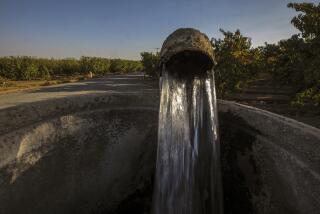Antelope Valley Told to Act Now to Avoid Future Water Shortages
- Share via
While the Antelope Valley’s water supply can sustain its rapid growth, long-term strategy must begin now to avert problems in the not-too-distant future, developers and government officials said Wednesday at a conference on water-related issues.
The region’s water supply can sustain the current level of growth for the next eight to 15 years, said Michael Azeka, a planning consultant who organized the workshop bringing together Antelope Valley commercial and residential developers, city planners and real estate consultants in Universal City.
But participants at the meeting agreed that this is the right time to be thinking about conservation issues.
Local governments and developers must emphasize conservation, education of residents and infrastructure improvements such as retention basins for rainwater that can be directed into the ground water supply, according to workshop participants.
Construction Boom
Over the past five years, the high desert has been swept up in a boom driven by construction of affordable homes in the area. The populations of the cities of Palmdale and Lancaster grew 17% and 10% last year, respectively. The two cities have issued more than 21,000 building permits in the past eight years.
Commercial development has followed housing, with several malls and large shopping complexes under construction, and experts predicted Wednesday that new jobs will come next in the cycle.
“This is the premier growth area in L.A. County,” said Robert Gardner, a partner in the real estate consulting firm of Robert Charles Lesser and Co. “It’s clear to us that employment and office space will move to where the people are.”
Gardner said the boom has the potential to spread through the desert to the Kern County line. But he and others pointed out that the speed of the growth raises questions about whether the availability of water will pose a barrier.
“The perception that there is not sure and certain water availability would change the investor mood,” he said.
Overall, however, experts said possible limits in the water supply will affect residential growth before business development, which--except for certain types of industry and services such as restaurants--uses less water. Antelope Valley leaders are working to correct what they perceive as a growing imbalance between residential and other forms of development, enticing employers to provide job alternatives for the estimated 40,000 residents who commute to other areas.
The Antelope Valley receives about half of its water from outside sources such as the California Aqueduct and about half from local wells. The demand for water in some developing areas has lowered ground-water levels, said engineering consultant Charles Brockmeier, but ground water has been replenished in former agricultural land that has been converted to less water-intensive residential uses.
Brockmeier said fundamental attitudes concerning water usage should be changed to increase the local water supply. For example, Azeka said, a federal study showed that landscaping accounts for 50% of water use in the Antelope Valley, a figure that can be reduced as developers and governments create new design standards emphasizing conservation.
And Antelope Valley households use 1,500 to 1,600 gallons of water a day, three times the amount used in Northern California regions where conservation measures have been imposed.
Annual Rainfall
In addition, Azeka said a 1987 study showed that only 5% of the yearly rainfall in the Antelope Valley goes into ground water. A long-term effort to improve drainage and build retention basins could increase that figure to 10%, enough to support a population of a million people, Azeka said. The current population in the Los Angeles County portion of the valley is more than 200,000 residents.
Participants called the workshop one of a series of meetings that will help better coordinate the work of developers, builders and governments in the Antelope Valley. This approach is needed to confront potential problems with water availability and other infrastructure issues before they become actual problems, Gardner said.
“We move very slowly as a society,” he said. “We have an opportunity now to move forward.”
More to Read
Sign up for Essential California
The most important California stories and recommendations in your inbox every morning.
You may occasionally receive promotional content from the Los Angeles Times.












